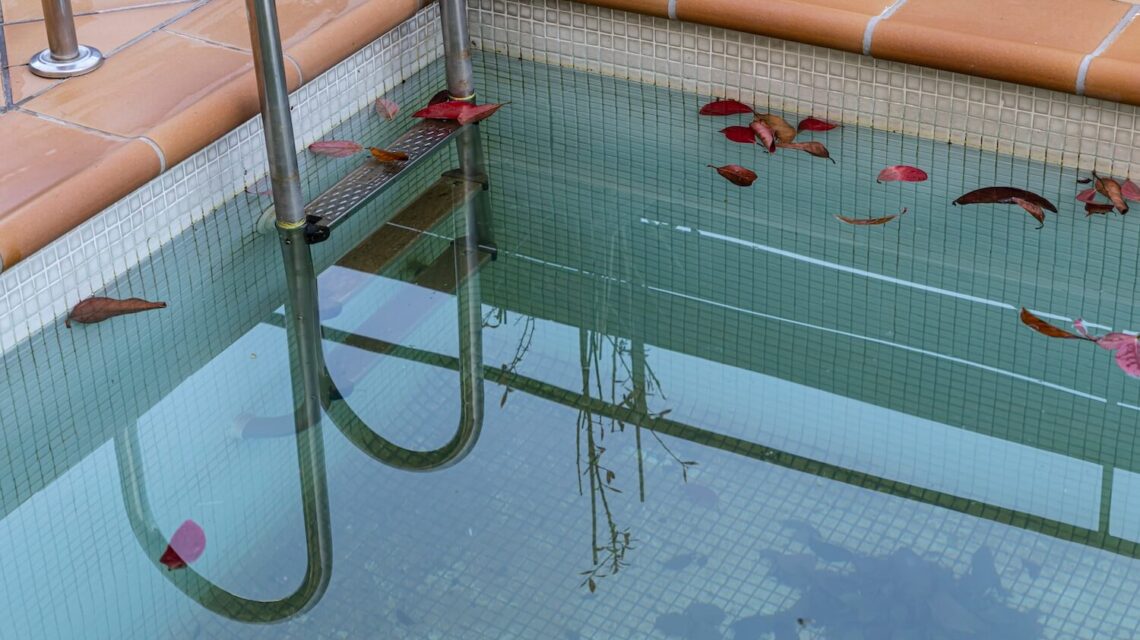Storms can leave behind a trail of destruction, and your swimming pool often bears the brunt of the chaos. From debris to algae blooms, the aftermath can be overwhelming. However, with the right approach and a bit of effort, you can restore your pool to its pre-storm glory.
Here’s a comprehensive guide to help you turn the turbulence of a storm into the tranquility of a pristine pool.
Assess the Damage
1. Safety First
Before diving into pool cleanup, ensure your safety and that of others. Storms can leave sharp objects and electrical hazards in their wake.
- Turn Off Electricity: Ensure that the pool pump, lighting, and other electrical systems are turned off to avoid any risk of electric shock.
- Check for Structural Damage: Inspect the pool for any signs of structural damage, such as cracks or broken tiles, which could pose safety risks.
2. Remove Large Debris
Large debris like branches, leaves, and other materials can cause significant damage if left unattended.
- Use a Pool Skimmer: Skim the surface to remove floating debris.
- Net and Basket: Use a leaf net and ensure the pool’s skimmer basket is emptied frequently during the cleaning process.
3. Inspect the Pool Equipment
Ensure that your pool equipment is still in working condition. Check the pump, filter, and other essential components for any signs of damage or clogging.
Clean the Pool Thoroughly
1. Skim and Vacuum
After removing the large debris, focus on cleaning the smaller particles.
- Surface Skimming: Continuously skim the surface to remove any remaining small debris.
- Vacuuming: Use a pool vacuum to clean the pool floor. For severe cases, a manual vacuum might be more effective than an automatic one.
2. Brush the Pool Walls and Floor
Storms can lead to the growth of algae and other microorganisms. Brushing the pool helps in dislodging these from the pool walls and floor. Brush the pool walls, floor, and steps thoroughly to prevent algae buildup and ensure a deep clean.
3. Clean the Pool Filter
Your pool filter will likely be overloaded with debris and dirt after a storm. It’s crucial to clean or replace it to maintain water clarity and hygiene.
- Backwash the Filter: For sand or DE filters, perform a backwash to clean them out.
- Clean or Replace Cartridge Filters: If you have a cartridge filter, clean it thoroughly or replace it if necessary.
Balance the Water Chemistry
1. Test the Water
After a storm, the chemical balance of your pool water is likely to be off. Testing the water is the first step in restoring the balance. Check the levels of pH, chlorine, alkalinity, and calcium hardness using a reliable pool test kit.
2. Adjust the Chemical Levels
Based on the test results, adjust the chemical levels to restore balance.
- pH Levels: Aim for a pH level between 7.4 and 7.6. Use pH increasers or decreasers as needed.
- Chlorine: Ensure the chlorine level is between 1.0 and 3.0 ppm. Shock the pool if necessary to eliminate contaminants.
- Alkalinity: Maintain total alkalinity between 80 and 120 ppm to prevent pH fluctuations.
- Calcium Hardness: Keep calcium hardness between 200 and 400 ppm to avoid scaling or corrosion.
Shock the Pool
1. Why Shocking is Necessary
Shocking your pool involves adding a large dose of chlorine or non-chlorine shock to quickly raise the chlorine level, killing bacteria, algae, and other contaminants introduced by the storm.
2. How to Shock Your Pool
- Choose the Right Shock: Depending on your pool type and current chemical levels, select an appropriate shock treatment (calcium hypochlorite, sodium di-chlor, or potassium peroxymonosulfate for non-chlorine shock).
- Follow Instructions: Read and follow the manufacturer’s instructions for dosage and application.
- Distribute Evenly: Pour the shock around the perimeter of the pool to ensure even distribution.
Run the Pool Pump and Filter
1. Circulate the Water
After shocking, run the pool pump and filter continuously for at least 24-48 hours. This helps to circulate the chemicals and remove any remaining contaminants.
2. Monitor and Backwash
Keep an eye on the filter pressure and backwash as needed to maintain optimal filtration.
Prevention Tips for Future Storms
1. Use a Pool Cover
Invest in a durable pool cover to protect your pool from debris and minimize cleanup efforts after a storm. Ensure the cover is securely fastened to prevent it from being blown away.
2. Trim Surrounding Trees
Regularly trim trees and shrubs around your pool area to minimize the amount of debris that could fall into the pool during a storm.
3. Maintain Proper Drainage
Ensure that your pool area has proper drainage to prevent flooding and contamination during heavy rains.
Post-Storm Maintenance
1. Regularly Check Chemical Levels
In the days following a storm, monitor your pool’s chemical levels closely and adjust as needed to maintain balance.
2. Clean Pool Accessories
Clean pool toys, floats, and other accessories that may have been contaminated by stormwater to prevent introducing bacteria back into the pool.
3. Inspect Pool Equipment
Regularly inspect your pool equipment for any signs of wear or damage caused by the storm and perform necessary maintenance or replacements.
4. Schedule Professional Maintenance
If the storm damage is extensive or you’re unsure about any aspect of the cleanup process, consider hiring a professional pool service to ensure thorough cleaning and repairs.
Calling a Professional After a Storm
While many pool owners are comfortable handling regular pool maintenance and minor repairs, the aftermath of a severe storm can present unique challenges that may require professional intervention. Here’s why and when you should consider calling in a professional, as well as what to expect from their services.
When to Call a Professional
- Extensive Debris and Contamination: If your pool is filled with a large amount of debris, mud, or other contaminants that make it difficult to clean with standard tools, a professional pool service can use specialized equipment to thoroughly clean your pool.
- Structural Damage: If you notice cracks, broken tiles, or any other signs of structural damage to your pool or surrounding areas, it’s crucial to call a professional. Attempting to fix these issues yourself can lead to further damage and expensive repairs.
- Equipment Malfunction: After a storm, pool equipment such as pumps, filters, and heaters may not function correctly due to debris or electrical issues. A professional can inspect, repair, or replace damaged equipment, ensuring that your pool operates safely and efficiently.
- Chemical Imbalance: Severe storms can drastically alter your pool’s chemical balance, introducing harmful bacteria and algae. Professionals can quickly and accurately test and adjust chemical levels, preventing potential health risks and algae blooms.
- Time and Expertise: Cleaning and restoring a pool after a storm can be time-consuming and physically demanding. If you lack the time, tools, or expertise, hiring a professional allows you to avoid stress and ensure the job is done correctly and efficiently.
Benefits of Hiring a Professional
Thorough Cleaning
Professionals have access to high-grade equipment and cleaning solutions that can remove even the most stubborn debris and contaminants from your pool, ensuring a deep and thorough clean.
Accurate Water Testing and Treatment
Pool technicians use precise testing methods to assess your pool’s chemical levels and apply the necessary treatments to restore balance quickly and safely.
Damage Assessment and Repair
Experienced pool professionals can accurately assess any damage to your pool’s structure or equipment and perform necessary repairs, preventing further issues down the line.
Efficiency and Convenience
Professionals can often complete the cleanup and restoration process more quickly than a DIY approach, allowing you to get back to enjoying your pool sooner.
Preventative Advice
A professional can provide valuable advice on how to better protect your pool from future storms, including recommendations for covers, fences, and maintenance practices.
What to Expect from Professional Services
When you hire a professional pool service after a storm, here’s what you can typically expect:
- Initial Assessment: The technician will conduct a thorough inspection of your pool and surrounding area, identifying debris, structural damage, and equipment issues.
- Debris Removal: Using specialized tools and equipment, the technician will remove all debris from your pool, including leaves, branches, dirt, and other contaminants.
- Equipment Inspection and Repair: The technician will inspect all pool equipment, including the pump, filter, and heater, and perform any necessary repairs or replacements.
- Chemical Testing and Adjustment: The professional will test the water for pH, chlorine, alkalinity, and other chemical levels, and apply the appropriate treatments to restore balance and ensure safe swimming conditions.
- Detailed Cleaning: This includes vacuuming the pool floor, brushing the walls and tiles, and backwashing the filter to ensure every part of your pool is clean and clear.
- Final Inspection: After cleaning and repairs, the technician will conduct a final inspection to ensure everything is in optimal condition and provide you with a detailed report of the services performed.
Choosing the Right Professional
When selecting a pool service professional, consider the following:
- Experience and Reputation: Look for a company with a solid track record and positive customer reviews. Experienced professionals are more likely to provide high-quality service and effective solutions.
- Certifications and Licensing: Ensure the company and its technicians are properly certified and licensed. This ensures they have the necessary training and adhere to industry standards.
- Insurance: Verify that the company carries adequate insurance. This protects you from liability in case of accidents or damages during the service.
- Transparent Pricing: Choose a company that offers clear, upfront pricing and detailed estimates. This helps you avoid unexpected costs and ensures you understand what services you’re paying for.
- Customer Service: Good communication and responsive customer service are crucial. Choose a company that is easy to reach and willing to answer your questions.
Conclusion
Calling a professional after a storm can save you time, effort, and potentially significant costs in the long run. With their expertise, advanced equipment, and thorough approach, professionals can swiftly restore your pool to a safe, clean, and enjoyable state. Don’t hesitate to reach out to a reputable pool service company like Pool Services of Central Florida when the storm leaves behind more than you can handle, ensuring peace of mind and a beautifully maintained pool.




